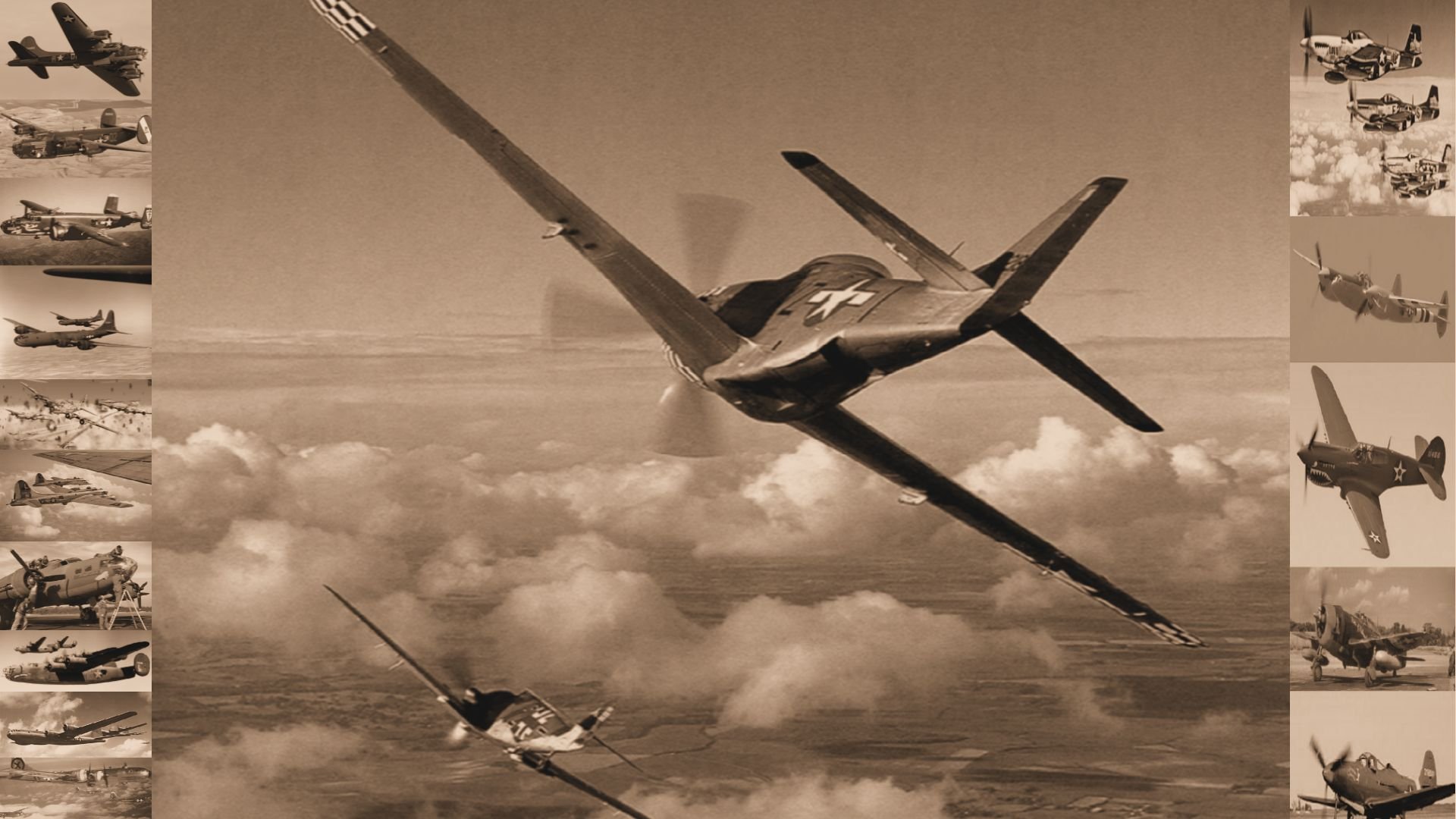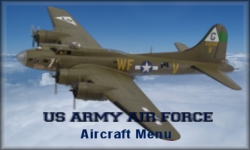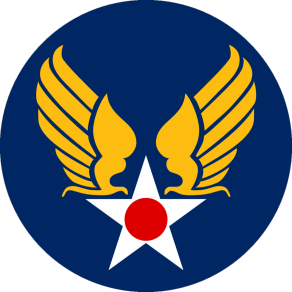



|

|

|

The United States Air Force
Creation
On August 1, 1907, the U.S. Army Signal Corps formed an Aeronautical Division. This action came only three-and-a-half years after the Wright brothers flew the world's first powered airplane at Kittyhawk, North Carolina. At first, however, the Aeronautical Division was mainly interested in balloons and dirigibles instead of heavier-than-air flying machines. The Army had already used manned balloons for aerial observation during the Civil War and Spanish-American War in the 19th Century. The Aeronautical Division accepted delivery of its first airplane from the Wright brothers in 1909. Renamed the U.S. Army Air Service, it was created during World War I after American entrance in April 1917 as the increasing use of airplanes and the military uses of aviation were readily apparent as the war continued to its climax, by executive order of 28th President Woodrow Wilson, it gained permanent legislative authority in 1920 as a combatant arm of the line of the United States Army. Back to TopWorld War 1 On April 2, 1917, President Woodrow Wilson went before a joint session of Congress to request a declaration of war against Germany. Upon arrival in France the aviation units, some of which were trained in France, provided tactical support for the U.S. Army, especially during the Battle of Saint-Mihiel and the Meuse-Argonne offensives. Among the aces of the American Expiditionary Forces(AEF) Air Service were Captain Eddie Rickenbacker and 2nd Lieutenant Frank Luke. Although failing to deploy competitive combat aircraft, the United States had sent many fine Airmen to Europe. Flying mostly French-built planes, they distinguished themselves both in Allied units and as part of the AEF led by General John J. Pershing. By the time Germany surrended, Brig. Gen. Billy Mitchell had honed many of the AEF's aero squadrons and groups into a formidable striking force which had grown to more than 19,000 officers and 178,000 enlisted men while American industry had turned out 11,754 aircraft (mostly trainers like the JN-4 Jenny). There followed a six-year struggle between adherents of airpower and the supporters of the traditional military services about the value of an independent Air Force, intensified by struggles for funds caused by skimpy budgets, as much an impetus for independence as any other factor. The Lassiter Board, a group of General Staff officers, recommended in 1923 that the Air Service be augmented by an offensive force of bombardment and pursuit units under the command of Army general headquarters in time of war, and many of its recommendations became Army regulations. Back to TopBetween the wars Renamed from the earlier United States Army Air Service on 2 July 1926, it was part of the larger United States Army and the immediate predecessor of the United States Army Air Forces (USAAF), established on 20 June 1941. Although discontinued as an administrative echelon in 1942 during World War II, the Army Air Corps (AAC) remained as one of the combat arms of the Army until 1947. On 1 March 1935, still struggling with the issue of a separate air arm, the Army activated the General Headquarters Air Force for centralized control of aviation combat units within the continental United States, separate from but coordinate with the Air Corps. The separation of the Air Corps from control of its combat units caused problems of unity of command that became more acute as the Air Corps enlarged in preparation for World War II. This was resolved by the creation of the Army Air Forces, making both organizations became subordinate to the new higher echelon. The Army and Navy, both cognizant of the continuing movement within the Air Corps for independence, cooperated to resist it. On 11 September 1935, the Joint Board, at the behest of the Navy and the concurrence of MacArthur, issued a new Joint Action statement that reasserted the limited role of the Air Corps as an auxiliary to the 'mobile Army' in all its missions, including coastal defense. The edict was issued with the intent of pushing the new Air Corps back into its place. However, the bomber advocates like Brig. Gen. Billy Mitchell, interpreted its language to mean that the Air Corps could conduct long range reconnaissance, attack approaching fleets, reinforce distant bases, and attack enemy air bases, all in furtherance of its mission to prevent an air attack on America. The lack of inter-service cooperation on coastal defense fostered by the Joint Action Statement continued until the Japanese attack on Pearl Harbor. In a special message to Congress on 12 January 1939, President Roosevelt advised that the threat of a new war made the recommendations of the Baker Board inadequate for American defense and requested approval of a "minimum 3,000-plane increase" for the Air Corps. On 3 April 1939, Congress allocated the $300 million requested by Roosevelt for expansion of the Air Corps, half of which was dedicated to purchasing planes to raise the inventory from 2,500 to 5,500 airplanes, and the other half for new personnel, training facilities, and bases. In June the Kilner Board recommended several types of bombers needed to fulfill the Air Corps mission that included aircraft having tactical radii of both 3,000 miles (modified in 1940 to 4,000) and 2,000 miles. Chief of Staff General Craig, long an impediment to Air Corps ambitions but nearing retirement, came around to the Air Corps viewpoint after Roosevelt's views became public. Back to TopWorld War 2 After September 1939, when Adolf Hitler launched World War II by invading Poland, the Army Air Corps began a steady growth from 26,000 personnel and fewer than 2,000 planes. The Army Air Corps had only 800 first-line combat aircraft, 700 of which were declared obsolete by December 1941. Two-thirds of its officers were second lieutenants whose only flying experience was their flight training. The Air Corps had 17 major installations and four depots, and most of its 76 airfields were co-located at civil airports or were small fields on Army posts. The initial 25-Group Program for air defense of the hemisphere, developed in April 1939, called for 50,000 men (12,000 pilots). Its ten new combat groups were activated on 1 February 1940. An 84-Group Program, with an eventual goal of 400,000 men by 30 June 1942, was approved on 14 March 1941, although not publicly announced until 23 October 1941. In addition to unit training and funding problems, these programs were hampered by delays in acquiring the new infrastructure necessary to support them, sites for which had to be identified, negotiated and approved before construction. On June 20, 1941, the Department of War created the Army Air Forces (AAF) as its aviation element and shortly thereafter made it coequal to the Army Ground Forces. The Air Corps remained as one of the Army's combat arms, like the infantry. Expansion of the AAF accelerated after the surprise Japanese attack on Hawaii in December 1941 propelled the United States into the war. The Air Corps ceased to have an administrative structure after 9 March 1942, but as "the permanent statutory organization of the air arm, and the principal component of the Army Air Forces," the overwhelming majority of personnel assigned to the AAF were members of the Air Corps. Under the leadership of Gen. Henry H. ("Hap") Arnold, the Army Air Forces oversaw mobilization of the nation's aviation industry and deployment of the largest air armada of all time. The AAF's inventory encompassed a wide range of training, transport, pursuit, attack, reconnaissance and bomber aircraft. These included the ubiquitous C-47 Skytrain, the splendid P-51 Mustang, the rugged B-17 Flying Fortress and the incredible B-29 Superfortress. Drawing upon American industrial prowess and human resources, the AAF reached a peak strength of 80,000 aircraft and 2.4 million personnel organized into major commands, numbered air forces, air divisions, groups and squadrons. USAAF units conducted a wide range of air operations over every theater of battle from the jungle-clad islands of the Southwest Pacific to the sun-baked deserts of Northern Africa, from the icy waters of the North Atlantic to the snow-capped peaks of the Himalayas. Back to TopModernisation On 18 September 1947 under the National Security Act of 1947 the United States Air Force(USAF) was formed. The Army Air Forces(AAC or USAAC) were abolished by Transfer Order 1, Office of the Secretary of Defense, September 26, 1947. The United States Air Force then became the aerial warfare service branch of the United States Armed Forces and one of the seven American uniformed services. Initially part of the United States Army, the USAF was formed as a separate branch of the military. It is the most recent branch of the U.S. military to be formed, and is the largest and one of the world's most technologically advanced air forces. The USAF articulates its core functions as Nuclear Deterrence Operations, Special Operations, Air Superiority, Global Integrated ISR, Space Superiority, Command and Control, Cyberspace Superiority, Personnel Recovery, Global Precision Attack, Building Partnerships, Rapid Global Mobility and Agile Combat Support. Aircraft designation changes One of the notable changes also, was the redesignation of aircraft type designations. Whereas fighters which were given the designation of 'P' for 'Pursuit Fighter' while under the operational use of the USAAF(1942-1947), the new designation removed the 'P' leaving fighter aircraft being designated as 'F' for fighter(e.g. P-51 Mustang became the F-51 Mustang) which led to some confusion of aircraft in the Korean War. The national insignia also changed, incorporating a red strip to the white extensions of the roundel. Back to TopPost War The Army Air Forces were legally abolished by legislation establishing a United States Department of Defense consisting of a Department of the Army (formerly the War Department), Department of the Navy and Department of the Air Force by Transfer Order 1, Office of the Secretary of Defense, September 26, 1947 at which time the United States Air Force(USAF) was formed. Over the next sixty years, the USAF would participate in Korea, Vietnam, Bosnia, the Gulf and Afghanistan as well as supplying civilians in the Berlin air lift. With the C-130 Hercules, the US Military has moved troops to hotspots rapidly all over the world in times of crisis. Armed also with the latest and deadliest aircraft like the F15 Eagle, F22 Raptor and the B2 Bomber as well as thousands of aircraft based all over the world, the USAF has become the dominant arm of political will thoughout the Western world and the Middle East. Todays Air Force The U.S. Air Force provides air support to ground troops and aids in the recovery of troops in the field. As of 2012, the service operates 5,484 aircraft, 450 ICBMs and 63 satellites. It has over 330,000 active personnel, over 185,000 civilian personnel, over 70,000 reserve personnel, and over 100,000 air guard personnel. 
US aircraft insignia from World War 1 to present day |